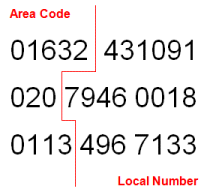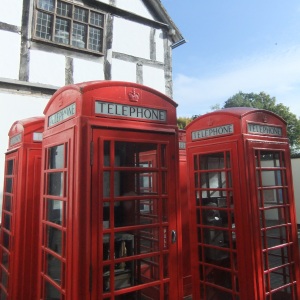Telephone area codes in the UK
In the UK, a full landline telephone number is made up of two parts: the area code, followed by a local number. Though the total length of a full UK number is always 10 or 11 digits, the area code and local number varies in length from area to area. Examples include:

The 'local number'
The local number is unique within the area covered by each area code. For example, there could only be one household or business with the number 234567 in the area covered by the Cambridge 01223 area code. However it would be possible for somebody living in a different area code to also have a local number of 234567.
In most areas, two landline telephones that share the same area code can call each other using just the local number. For example, if somebody in Cambridge dials 234567 they will be connected to that number in Cambridge.
Local dialing without including the code is not available in selected areas, as part of a series of measures to handle localised shortages of available phone numbers.
The 'area code'
An area code is used to connect a call outside the area local to the person making the call - for example, somebody in Newcastle (area code 0191) may want to dial Glasgow 4960018 (area code 0141). Just dialling 4960018 would work within Glasgow, but dialling it in Newcastle would connect to Newcastle 4960018. So, an area code is added to route the call out of Newcastle and into Glasgow - in this case, the full number dialled would be 0141 4960018.
So, an area code is used to connect a call to a local number outside the caller's own area code. It also uniquely identifies an area - all numbers beginning 0117 are in Bristol, for example.
Presentation
As area codes vary in length, it is necessary to write them in a way that shows others which part of a number is the optional area code, and which is local number. This is normally acheived using spaces and brackets.
For example, a telephone number in Sheffield, which has seven-digit local numbers and an area code of 0114, could be written:
- (0114) 272 6444
- 0114 272 6444
- (0114) 2726444
- 0114 2726444
- Sheffield 272 6444
- Sheffield 2726444
It would be wrong to write 01142 726444 or (01142) 726444 as this incorrectly suggests that the local number is only six digits long.
Coverage of area codes
The coverage of each area code is generally linked to the development of BT's phone network and the historic positioning of their telephone exchanges. There is no correlation between area codes and postcodes or local government areas.
Official names for each area code were determined following an Oftel consultation in 2003.
Although regulator Ofcom associates a geographic area (usually a large town) with each code and encourages operators to respect this, there are generally no officially-published boundaries to UK area codes. The 01987 area code for the new town of Ebbsfleet is one exception: it was newly-created in 2008 and has a precisely-specified boundary.
More recently-established phone companies usually follow the same pattern as BT when assigning numbers to customers, although the boundary between two area codes can vary slightly between operators.
Additionally, although area codes still have strong local identities, there are now many numbers without a physical link to their area code. For example, companies will supply telephone numbers that look like a regular local landline number but in fact forward calls to a completely different location.
